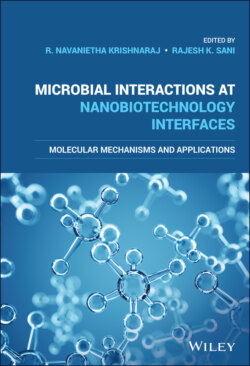Читать книгу Microbial Interactions at Nanobiotechnology Interfaces - Группа авторов - Страница 41
1.7.1 Nanometals
ОглавлениеMetals over a threshold concentration exhibit toxicity on the biological system. Among them, heavy metals such as arsenic, cadmium, chromium, lead, and mercury are highly toxic to the living system (Tchounwou et al., 2012). The property of metal toxicity has been exploited to prepare antibacterial nanometals that are toxic to bacterial cells. An additional advantage of nanometals is the possibility of tuning the properties of the system during the synthesis phase.
Metal NMs include silver NPs, copper NPs, and iron NPs. Silver NPs are one of the well‐known antimicrobial materials that have been used in various healthcare, industrial, and medicinal sectors, their mechanism of action being the toxic effect of Ag+ ions exerted by interacting with sulfhydryl groups in proteins. Further, silver ions also inhibit DNA replication and also affect the cell membrane integrity, thus compromising the permeability (Feng et al., 2000). Wigginton et al. (2010) showed that the Ag NPs have high affinity for tryptophanase protein of E. coli. It is evident from the literature that the enzyme tryptophanase is crucial for the production of indole from tryptophan amino acid where indole plays a crucial role behind the multidrug exporters and also acts as a signaling molecule in biofilm formation. It was clearly evident from the study that the binding of Ag NPs deactivated the enzyme which could make the bacteria prone to effect of drugs and other antimicrobial materials (Wigginton et al., 2010). Ag NPs exhibited bactericidal activity by inactivating the enzyme phosphomannose isomerase in bacteria, which converts mannose 6 phosphate to fructose 6 phosphate. This conversion is one of the crucial steps in glycolysis of bacterial sugar metabolism (Dakal et al., 2016; Sundar & Kumar Prajapati, 2012). In another study, Elechiguerra et al. (2005) showed that the interaction of Ag NPs with HIV‐1 was not random but based on the structure of virus envelope. The envelope consists of a protruding gp120 glycoprotein connected to intracellular matrix protein p17 through a transmembrane glycoprotein gp41. Importantly, HIV‐1 binds to CD4 receptor sites on the host cell using gp120 protein knobs. It was observed in this study that Ag NPs attach to the HIV‐1 surface by sulfur‐containing residues of the gp120 protein (Elechiguerra et al., 2005). Next to silver NPs, copper NPs have gained attention in the past few years as cost‐effective alternatives to the former. Copper NPs also exert a mechanism similar to that of silver. They act by damaging the bacterial cell wall and disrupting the DNA structure (Raffi et al., 2010).
